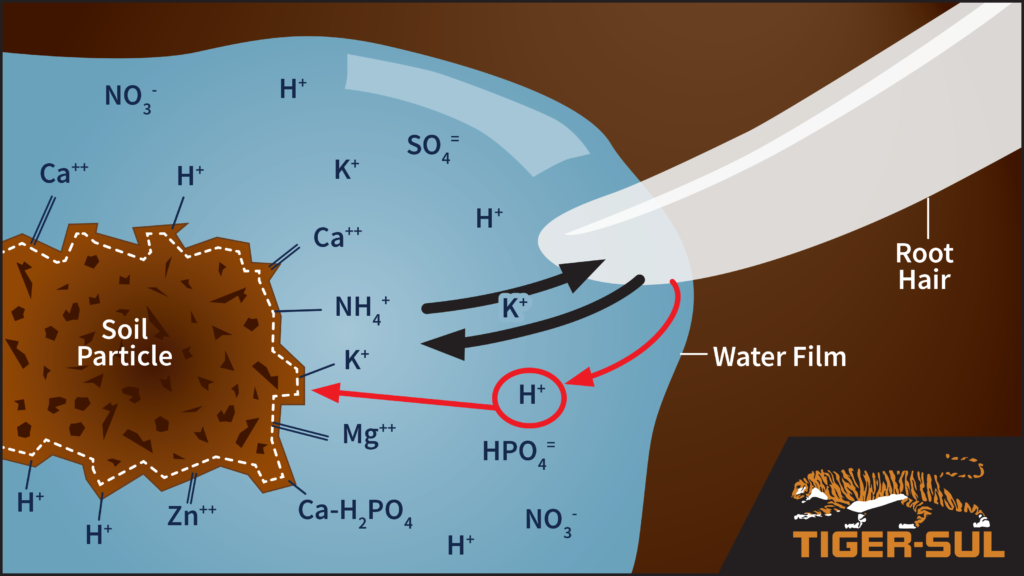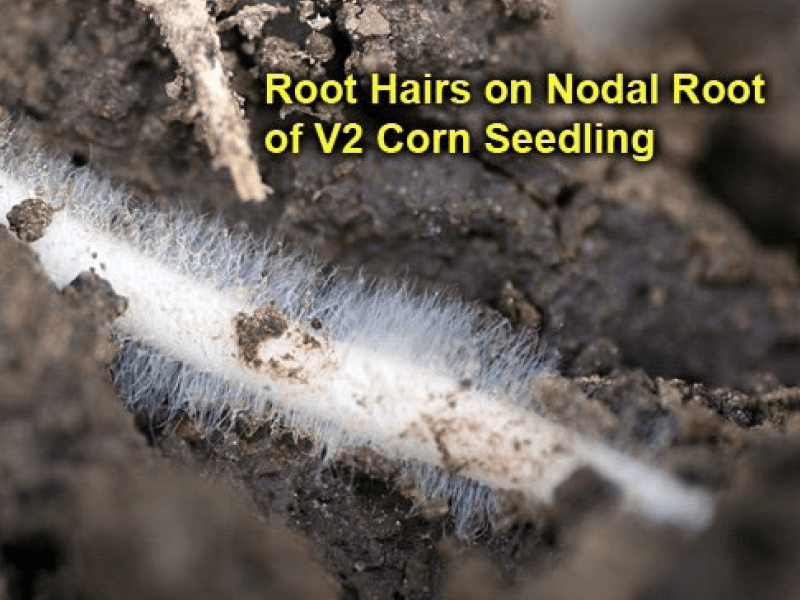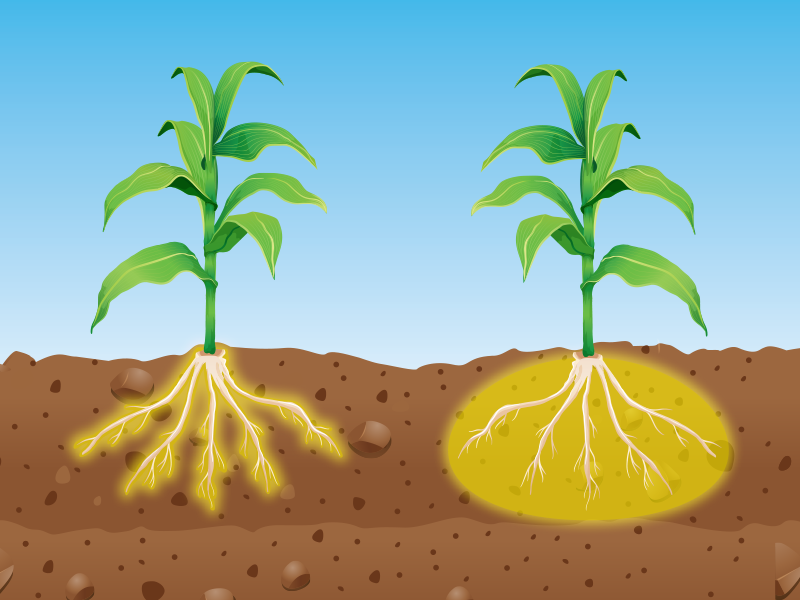Functionality of Tiger-Sul Products in Nutrient Uptake
Crop production specialists do very good job of evaluating soil test results, identifying plant stress factors, and providing appropriate recommendations from an above ground plant growth standpoint.
Individuals working with crop production tend to overlook the importance of plant roots and the influence they have on the plant, maximizing its growth, and productivity potential. Many crop production specialists and producers are much less familiar with the physiology of plant root growth and nutrient uptake process. Since roots are buried in the soil they tend to be “out of sight – out of mind,” and do not receive the attention required for efficient crop production. Soil is the environment where plants are anchored by the root system, obtain water, and acquire 13 of the 16 essential elements required for growth.
In soil fertility agronomists are concerned with the physical, biological, and chemical environment within the soil. Before a nutrient ion can be taken-up by the plant, it must be in a proper chemical form and adjacent to the root surface. The availability of a given nutrient is a function of plant roots growing toward it or if the nutrient can be moved to the roots’ surface. The three methods of nutrient uptake are root interception, mass flow, and diffusion. Root interception is the process where the root actually grows into the ion and is absorbed into the root. Nutrient ions that are not attached within the cation exchange complex are mobile in the soil. Those mobile ions are soluble in soil solution and can move with the soil water as it flows across the root system is referred to as mass flow. The pre-dominate ions delivered via mass flow are nitrate (NO3–) and sulphate (SO4-2). Diffusion is the process where the nutrient ions in soil solution move from an area of higher concentration to an area of lower concentration. Significant quantities of phosphorus (P2O5) and potassium (K2O) enter into the plant’s root system by diffusion.
Plant Nutrient Uptake Process

Figure 1.0: Cation exchange and uptake by plant roots.
Efficient plant nutrient uptake requires a very close interaction at the root- soil interface. The interaction is enhanced with exudates from the roots and microbial population (mycorrhizae fungi) in the area where roots and soil interface. This very narrow zone is referred to as the rhizosphere. Mycorrhizae enhance the uptake of some elements by the plant root system. The nutrient uptake process is enhanced as a protein carrier is excreted to bind with a nutrient ion and transport it across the root cell wall. The root excretions also contain an acid which releases H+ ions into the rhizosphere. Since the H+ ions have higher bonding strength they displace the weaker bonding cations which become more readily available for plant uptake as illustrated in Figure 1.0. By adding sulphur bentonite such as Tiger-Sul products the oxidation process releases acid that can contribute to greater release of cations (nutrients) from the soil particles. “The root discriminates and only expends energy to take up nutrients it needs. Thus, nutrient uptake is not proportional to the ratios of nutrients in the soil solution” (Mengel, 1995).
Generally, plant nutrient uptake rate corresponds with vegetative growth rate. During the rapid growth phase nutrient uptake rate is the greatest. Mobile nutrients are stored in leaf and stem structures and translocated to the seed or other sink structures during the reproductive growth stage. “Only specific areas of the root cylinder absorb water and nutrients” (Mengel & Kirkby, 1982). “The rate at which a given segment of root absorbs nutrients or the demand for nutrients placed on the root system also changes drastically over the growing season” (Mengel, 1995).
As the plant enters the rapid growth phase, the number of roots capable of nutrient uptake increases significantly. “This is an important concept. If root growth is restricted by some factors such as compaction, cold temperatures, wet soils, or insect feeding, increasing the availability of nutrients in the soil solution through starter fertilizer. Use applications might have some impact on over-coming nutrient uptake restrictions” (Mengel, 1995). “It stands to reason that soil factors controlling root growth have a much greater impact on plant productivity than the supply of nutrients in the soil. The rooting volume of the plant is the principal factor governing nutrient and water uptake. Any condition that reduces the rooting volume of a plant must necessarily reduce yield” (Walters, 2011). Banding or in-furrow applications may increase nutrient availability but may not increase nutrient uptake. In small plants the root system will be small, and the uptake will be limited by the rate at which the nutrients can be absorbed. It is possible that lower availability with greater root exposure to the available nutrients can result in greater uptake. Therefore, it is oftentimes recommended to utilize a combination of application methods to maximize plant nutrient availability. The starter band will provide an area of high nutrient availability when the root system is small, and the broadcast application will provide greater area for root contact as the root system expands and plant demand increases (Mengel, 1995).
Types of Roots

Figure 2.0: Root hairs on young corn root. These hairs are short, but very dense increasing the total surface area for nutrient contact. Photo: R.L. Nielsen, Purdue University.
Plants have either a fibrous root system or a tap root system. Monocotyledon (monocots) plants have a dense fibrous root system composed of small slender roots. These roots have a short life span and are replaced every few weeks. Some fibrous roots can serve as carbohydrate storage as in sweet potato. This type of rooting system has some primary roots that originate from the crown or seed and adventitious roots that develop from stem nodes or lateral roots.
Dicotyledon (dicots) plants have tap roots that grow vertically into the soil profile with some lateral branching. These tap roots can serve as modified storage tissue such as in carrots and sugar beets. Tap roots have the ability to capture nutrients and moisture deeper in the soil profile. The amount of adventitious (lateral) roots that emerge from the tap roots are somewhat species specific.
Both types of root systems provide the support and food storage for plants, but the nutrient absorption occurs through the root hairs located predominately near the root tip. The root hairs are small but increase the root absorptive surface area significantly (Figure 2.0). Root hairs enlarge the surface area of the root cylinder by a factor of 2-3. Root hairs enhance access to the nutrients in the soil as they protrude from the root cylinder perpendicular into the soil.
Ample supply of all required nutrients in soil solution throughout the growing season is critical. “Such a balance tends to ensure the desirable physiological conditions necessary for successful plant production. The pH of the soil solution, since it influences profoundly many of the important soil and plant processes, plays a critical role in such an adjustment” (Brady, 1974). The addition of Tiger-Sul Sulphur products to a planned plant nutrient management program will contribute to soil pH adjustment at the root-soil interface. Soils with pH > 7.5 tend to realize significant benefit from the Tiger-Sul Sulphur additions. When the soil pH is in the optimum range within the rhizosphere provides opportunity for plant roots to maximize their nutrient uptake potential. Recent research has shown increased nutrient uptake and crop yields where Tiger-Sul Products were included in fertilizer application. Further details are in the TigerTech Newsletter – Sulphur Enhances Plant Nutrient Utilization Efficiency, October 2014.
Nutrient Mobility and Plant Competition

Figure 3.0: Plant on left represents the uptake zone available for the nutrients not mobile in the soil. Plant on right illustrates the nutrient uptake zone for the nutrients that are mobile in the soil. Adapted from Kansas State University, Extension.
Nutrients mobile in the soil such as sulphate (SO4) and nitrate (NO3) have a large root uptake zone, especially for the fibrous root systems. These mobile nutrients are moved through the root zone and across the root via mass flow. The immobile nutrients such as phosphorus (P), potassium (K), and zinc (Zn) have a limited root uptake zone and depend on diffusion for the uptake process (Figure 3.0).
Roots from neighboring plants compete for the mobile nutrients. There is minimal competition between plants for the immobile nutrients. The plant nutrient uptake mechanism is an interactive and dynamic process that varies with plant demands. Many factors influence the process such that availability does not always translate into plant uptake. A well-planned nutrient management program incorporates many of the influential factors to ensure sufficient nutrients are available when plant demand occurs. Since sulphate (SO4) is one of the mobile nutrients in the soil, distribution is important to maximize access for all rooting types. Plants may respond to a S-deficiency by increasing their capacity for sulphate uptake and increase root size/mass to explore greater volume of soil. The size increase may be more development of root hairs close to root apices. Employment of the 4Rs best management practices enhances the opportunity to capitalize on plant’s genetic potential to maximize its growth and production through plant nutrient application at right source, right rate, right time, and right place.
“The challenge to every farmer is creating a soil environment in which roots can grow without constraint. Only when this condition is met can we begin talking about plant health and maximizing yield potential. If roots do not function properly no amount of nutrient content in the soil will increase plant productivity” (Walters, 2011).
References: